Rimantė Bandzevičiūtė
Šviesolaidinė ATR IR spektroskopija vėžinių audinių diagnostikoje
Atsižvelgiant į iššūkius, susijusius su navikinių audinių diagnostika, yra reikalinga portabili, veikianti realiu laiku ir patikima spektrinė sistema, tinkama taikyti audinių tyrimams in situ ar net in vivo sąlygomis. Disertacijos tikslas – pritaikyti šviesolaidinę ATR IR (pažeistojo visiškojo vidaus atspindžio infraraudonosios sugerties) spektrinę sistemą biologinių audinių tyrimams, galimiems vykdyti intraoperatyviomis sąlygomis. Tyrimo metu buvo taikyta šviesolaidinė spektrinė sistema po operacijos pašalintų įvairių organų (inkstų, šlapimo pūslės, kasos ir kepenų) normalių ir navikinių audinių identifikavimui.
Disertacijos tyrimų metu nustatyta, jog taikoma spektrinė sistema, sudaryta iš šviesolaidinio ATR IR zondo, sujungto su standartiniu mobiliu FT-IR spektrometru ir išoriniu MCT tipo detektoriumi, yra pakankamai jautri rezekuotų audinių informatyvių spektrų registravimui. Spektrai, užregistruoti naudojant šviesolaidinę spektrinę sistemą, leidžia nustatyti specifines savybes, būdingas skirtingiems audinių tipams. Spektriniai žymenys, tokie kaip glikogenas, kolagenas ir fruktozės-1,6-bisfosfatazė gali būti naudojami normalių ir navikinių audinių identifikavimui. Tačiau nėra vieno universalaus spektrinio navikų žymens, tinkamo visų žmogaus organų vėžio aptikimui. Kiekvienam organui turi būti nustatytas specifinių navikinių spektrinių žymenų rinkinys. Šviesolaidinė ATR IR spektroskopija kartu su statistinės analizės metodais, taikomais įvairių žmogaus organų (inkstų, šlapimo pūslės, kasos ir kepenų) audinių ATR IR spektrams leidžia sėkmingai identifikuoti normalius ir navikinius audinius iki 100 % tikslumu.
Cheminės fizikos institutas. Mokslinis vadovas – dr. Justinas Čeponkus.
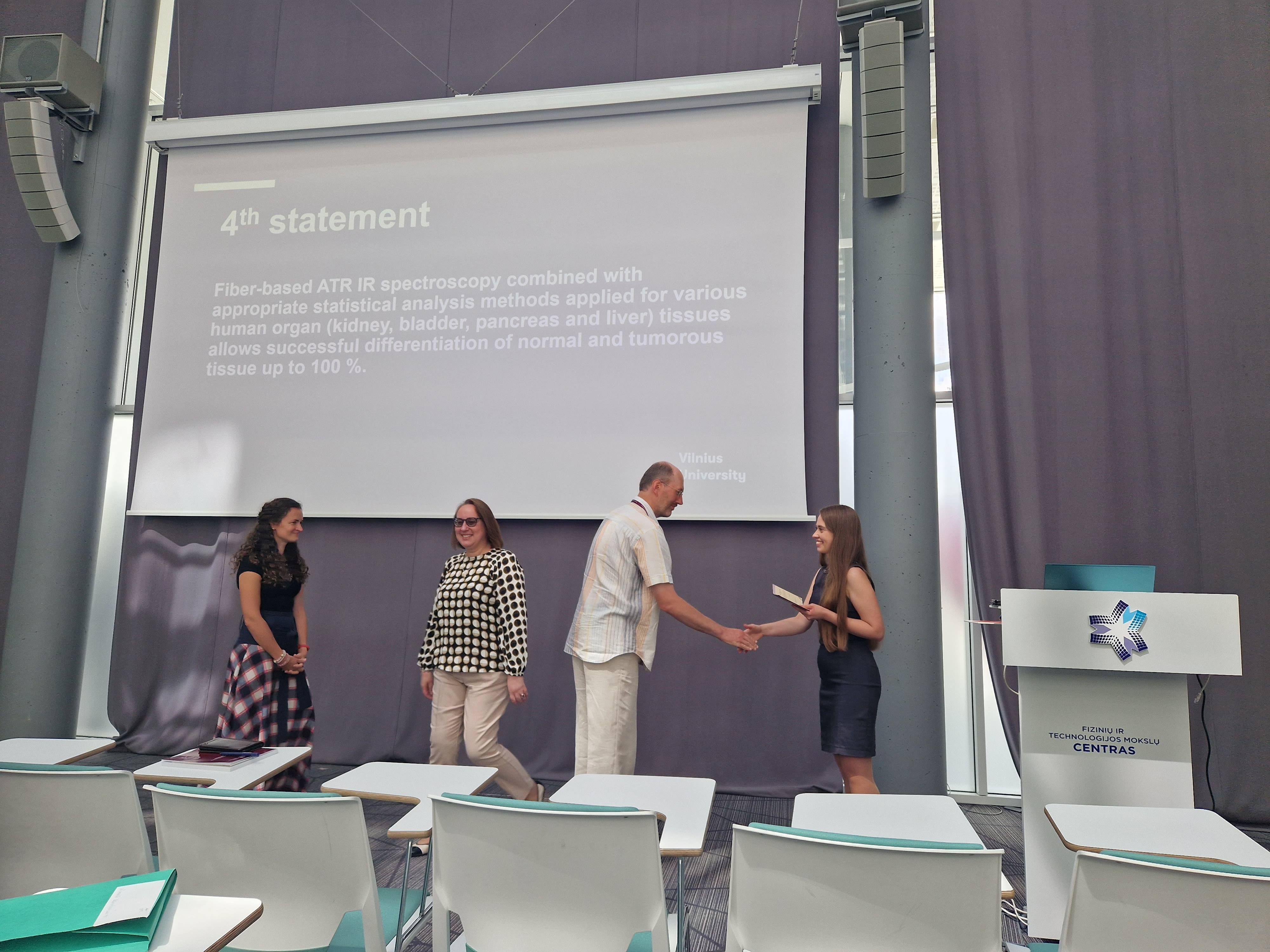
Agnė Butkutė
Funkcinių laisvai parenkamos architektūros mikrodarinių gamyba iš skaidrių medžiagų, panaudojant femtosekundiniu lazeriu indukuotą selektyvų ėsdinimą
Skaidrios ir tvirtos medžiagos, kaip antai techniniai stiklai bei kristalai, dėl savo mechaninių ir optinių savybių yra patrauklūs daugelyje sričių. Tačiau minėtosios medžiagos yra ganėtinai trapios, tad sunku jas apdirbti. Femtosekundiniu lazeriu paremtas medžiagų apdirbimas yra patraukli alternatyva apdirbti stiklus bei kristalus. Selektyvaus lazeriu indukuoto ėsdinimo (SLE) technologija yra geras pasirinkimas kompleksinių 3D komponentų formavimui iš stiklo. SLE yra metodas, sudarytas iš kelių technologinių procesų, kai pirmiausia stiklo tūryje yra įrašomos porėtos modifikacijos, vadinamosios nanogardelės. Galiausiai šios modifikacijos yra ėsdinamos agresyviuose ėsdikliuose, kaip antai hidrofluoridinė rūgštis ar kalio šarmas. Tokiu būdu gali būti formuojami laisvos architektūros dariniai iš stiklų ar kristalų. Dėl didelio selektyvumo, naudojant SLE metodą, galima suformuoti itin aukšto matmenų santykio struktūras, kaip kad: mikromechaniniai prietaisai, mikrofluidiniai prietaisai ar net itin sudėtingos mikrofluidinės sistemos su integruotais mikromechaniniais komponentais. Minėta technologija atrodo perspektyvi daugelyje sričių: SLE pagamintos struktūros gali būti taikomos sensorikoje, laboratorijų ant lustų, purkštukų gamybai ar kitose srityse. Todėl ši disertacija skirta lydyto kvarco SLE metodo tobulinimui ir kristalinio safyro SLE metodo vystymui. Galiausiai tyrimų metu įgytos žinios pritaikytos funkcinių darinių, kaip antai mikrofluidinių ir mikromechaninių prietaisų, gamybai SLE metodu.
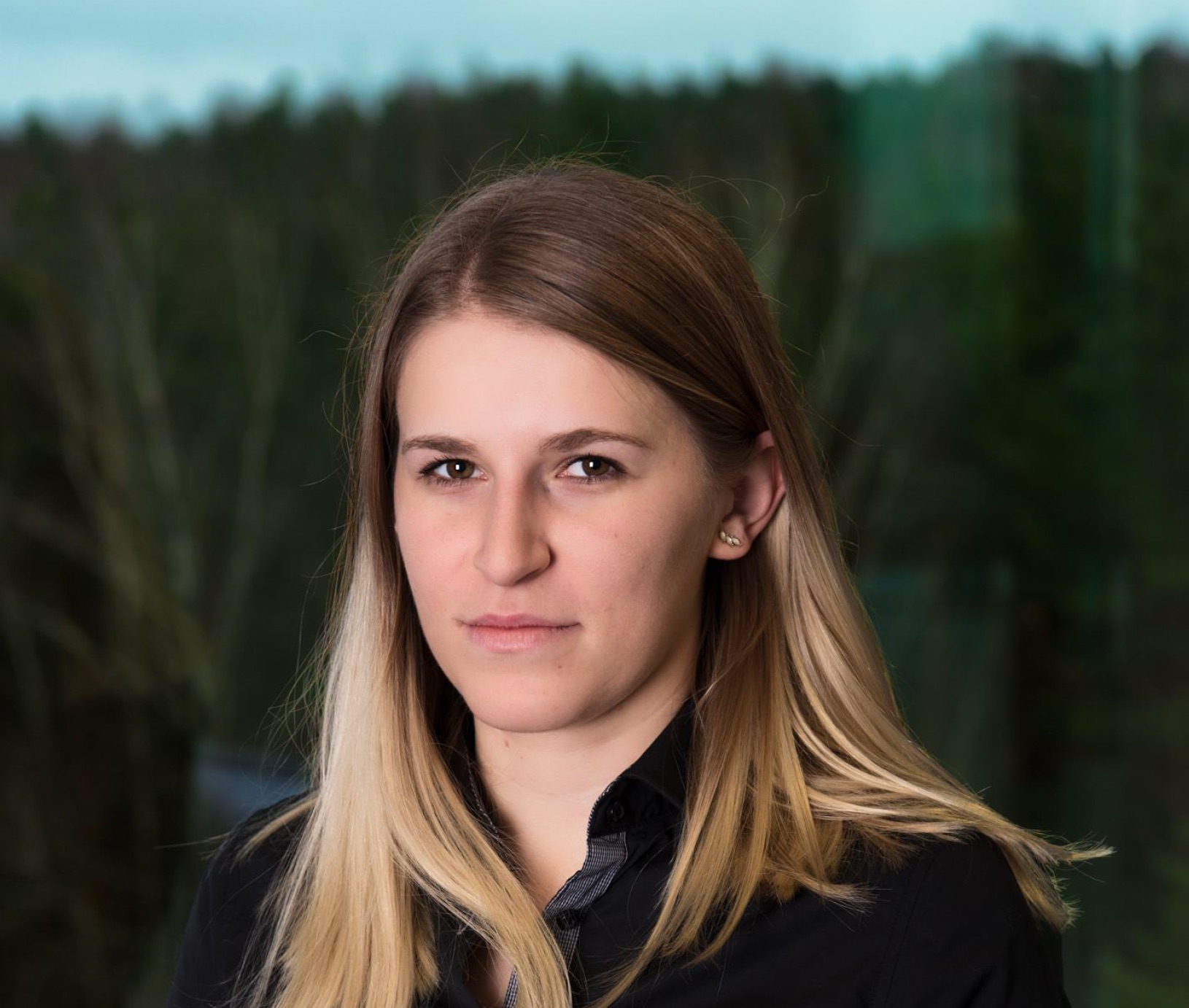
Greta Merkininkaitė
Additive manufacturing of inorganic 3D nanostructures by combining laser lithography and pyrolysis
Over the past decades, ceramic materials and the 3D structures derived from them have been receiving increasing attention due to their exceptional mechanical, chemical, and thermal properties. As interest in 3D ceramic micro/nanostructures grows, there is a corresponding rise in demand for new materials and production processes for creating 3D entities. Therefore, the aim of this dissertation is to synthesize various metal organic compounds using sol-gel methods and produce ceramic/crystalline 3D micro/nanostructures through the combination of femtosecond laser photopolymerization and pyrolysis.
This dissertation demonstrates high-resolution and robust methods for fabricating 3D ceramic structures, encompassing the synthesis of novel materials, their application in 3D multiphoton lithography, and changes in structural crystalline phases following thermal processing. A novel direct method for measuring the crystalline phase of 3D microstructures is introduced for the first time. Also, aresolution record was achieved. The width of lines in periodic 3D ceramic SiO2/ZrO2 structures was less than 60nm. Additionally, a new silicon-organic material with unique mechanical properties was developed. When this material was employed in 3D lithography and the resulting structures underwent pyrolysis, it was observed that amorphous SiOC or crystalline SiC and/or α,β-Si3N4structures formed. These structures remained free from defects, with hardness andand reduced elastic modulus measuring approximately ≈15 GPa and ≈105 GPa.
These accomplishments have addressed the challenges in producing solid and precise 3D structures and expanded this technology's potential applications in the industry.
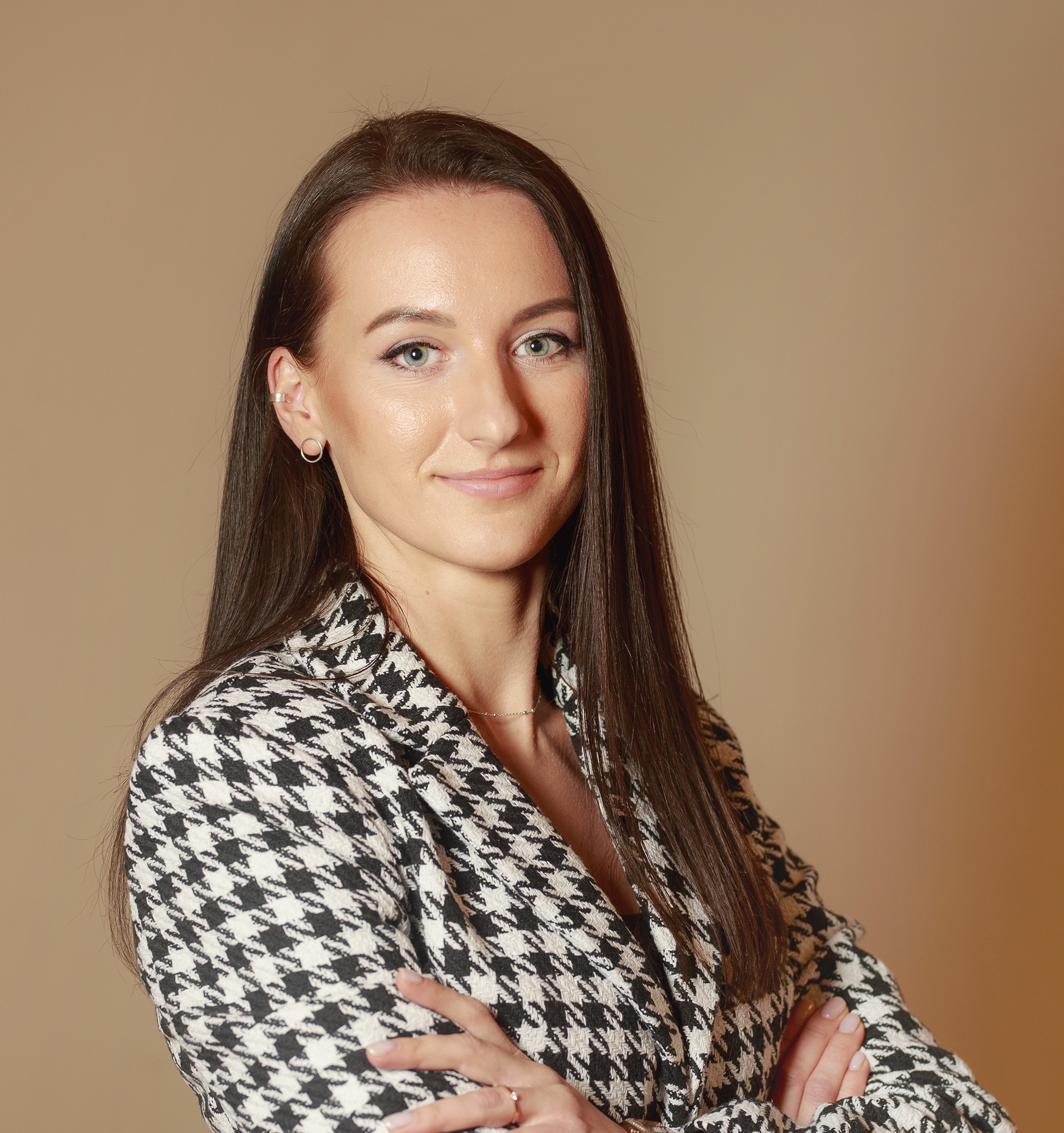
Edvinas Skliutas
MultiscaleStructuring: InvestigationofLocalizationandNonlinearityofPhotopolymerizationbyVaryingRadiationExposureParameters
Optical three-dimensional printing (O3DP) is an additive manufacturing technology when a material exposed to light solidifies. Using various light sources – continuous and pulsed –we can achieve different types of light absorption in the material: linear and non-linear absorption. This allows the production of 3D objects with dimensions ranging within 8 orders of magnitude: from hundreds of nanometers to centimeters. Therefore, O3DP has a wide field of applications: from prototyping and small-scale production to the production of micro-optics components, photonics, formation of structures with metamaterial properties, medicine, and tissue engineering. In the dissertation, research was focused on the size of the area of the material exposed to light and manufacturing characteristics. A study of the lateral and longitudinal dimensions of the produced spatial pixels – voxels – was performed depending on the wavelength and pulse duration. The effective degree of absorption was estimated from these data. It was also determined how the polymerization and optical breakdown thresholds change and how this affects the choice of fabrication parameters. Fabrication conditions were investigated in material without photoinitiator using a non-amplified pulse laser system (high repetition rate). A lot of attention has also been paid to the application of plant-derived materials, using linear and nonlinear absorption, and thus demonstrating multiscale O3DP. The results of this thesis showed that toachieve the desired production performance and the size of the manufactured items, it is important not only to modify the properties of the material, but also to be able to widely adjust the parameters of the equipment.
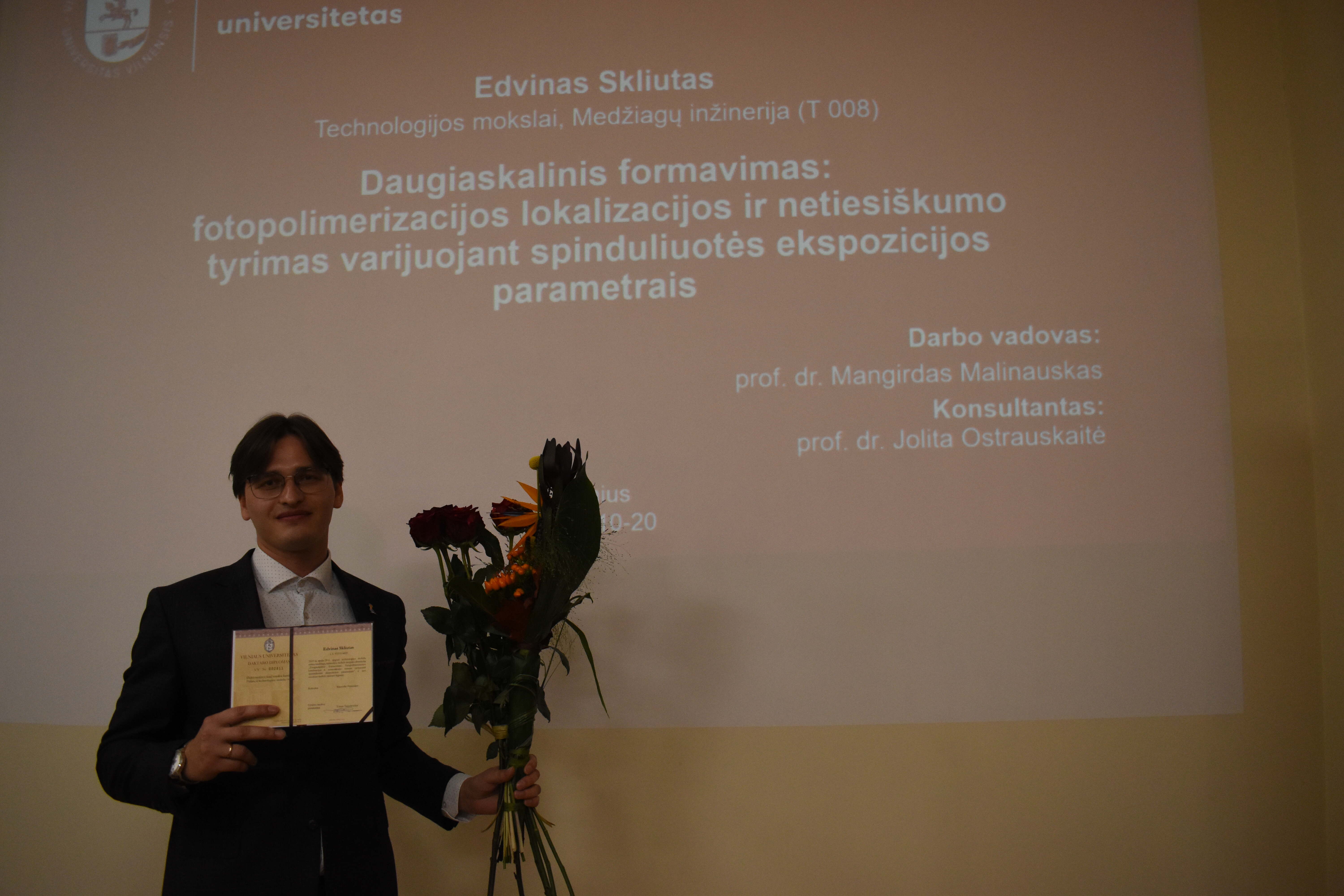
Jurgita Koncevičiūtė
Theoretical Study of Electron-Impact Double and Triple Ionization Using a Multi-Step Approach
Electron-impact multiple ionization is a process that involves dealing with at least four-body Coulomb problem, making the study of such a process complicated. In this dissertation, a multi-step approach is utilized to study electron-impact double and triple ionization processes for Se2+, Se3+, and B+ ions. The multi-step approach treats electron-impact direct double ionization as a sequence of separate ionization and excitation processes, thereby dividing the complex multiple ionization problem into simpler components. It encompasses two- and three-step processes through which direct double ionization can occur, including ionization-ionization, excitation-ionization-ionization, and ionization-excitation-ionization paths. The energy distribution of the electrons participating in subsequent ionization or excitation processes after the initial interaction is also studied. For indirect double ionization, additional excitation-ionization-autoionization and ionization-excitation-autoionization processes are considered. Electron-impact triple ionization is studied as a sum of the direct double ionization process followed by autoionization and Auger cascades after the ionization of the inner shell of the considered ion. The dissertation demonstrates the significant influence of three-step processes on double and triple ionization.
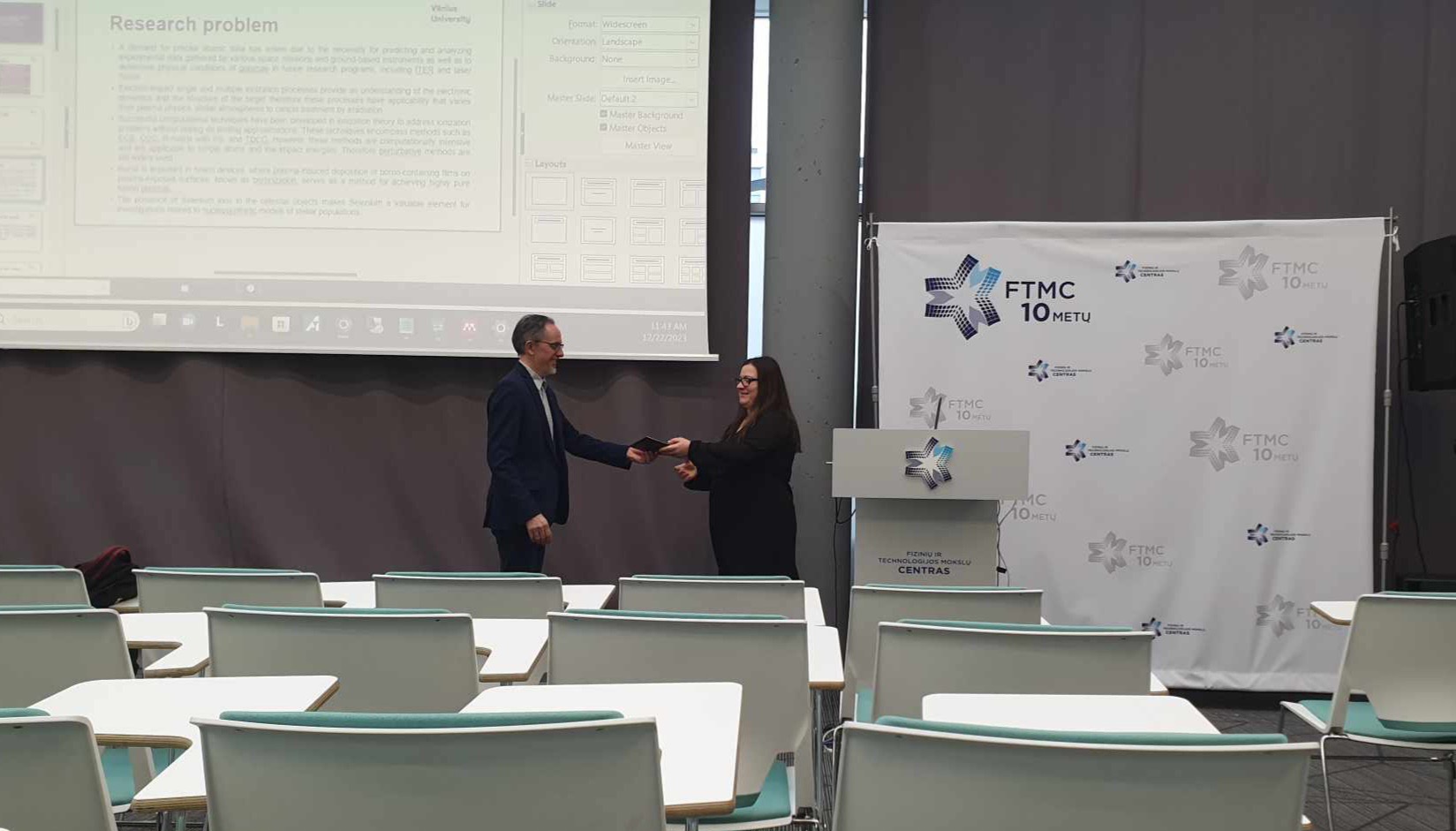
Mantas Jakučionis
“Relaxation Theory of Quantum Systems with Feedback: Development of Methods Based on Principle of Time-Dependent Variations”
The function of many biological molecular systems is closely tied to the process of energy relaxation. Understanding the pathways and rates of energy relaxation induced by photoexcitation is relevant across a range of molecular spatial scales. This includes the smallest molecules, intermediate-sized molecular aggregates, and the largest photosynthetic complexes found in nature, which may involve physical processes such as molecular energy relaxation, charge transfer, and spatial energy transfer across structures composed of tens or hundreds of molecules.
The work explores the use of the family of Davydov’s trial wavefunctions, which expand the model’s vibrational eigenstates in terms of time-dependent coherent states. During time evolution, these wavefunctions continuously adjust to align with the most relevant eigenstates at any given moment.
As excitation energy relaxation occurs in the model, the temperature of the model increases. The standard approaches lack a direct energy exchange mechanism between vibrational degrees of freedom, violating the assumption of constant temperature and introduces errors. The theoretical problem of vibrational heating mirrors a natural process, during which a large amount of thermal energy to its immediate surroundings. Subsequently, a cooling process – thermalization, occurs where the excess heat dissipates away from the molecules.
This work proposes a theoretical formulation, implementation and investigation of thermalization to be used with Davydov’s trial wavefunctions.

Baigęs doktorantūrą ir mokslo daktaro laipsnį įgijęs asmuo geba savarankiškai atlikti mokslinių tyrimų ir eksperimentinės plėtros darbus bei spręsti mokslo problemas. Jis įgija pažangiausių tiriamojo darbo, mokslo sričių ir jų sąveikos žinias, specializuotus gebėjimus ir metodikas mokslinių tyrimų ir kitų sričių problemoms spręsti bei turimoms žinioms ar profesinei praktikai plėsti, gebėjimą dirbti savarankiškai, mokslo ir profesijos išmanymą naujoms idėjoms ar procesams kurti ir panaudoti studijose bei kitoje veikloje.
